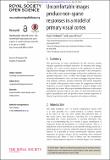Files in this item
Uncomfortable images produce non-sparse responses in a model of primary visual cortex
Item metadata
| dc.contributor.author | Hibbard, Paul B. | |
| dc.contributor.author | O'Hare, Louise | |
| dc.date.accessioned | 2015-07-15T15:40:05Z | |
| dc.date.available | 2015-07-15T15:40:05Z | |
| dc.date.issued | 2015-02-25 | |
| dc.identifier | 202738042 | |
| dc.identifier | 20ee1198-8b54-4920-ad6f-63e04349759e | |
| dc.identifier | 84947738743 | |
| dc.identifier | 000377964700017 | |
| dc.identifier.citation | Hibbard , P B & O'Hare , L 2015 , ' Uncomfortable images produce non-sparse responses in a model of primary visual cortex ' , Royal Society Open Science , vol. 2 , no. 2 . https://doi.org/10.1098/rsos.140535 | en |
| dc.identifier.issn | 2054-5703 | |
| dc.identifier.other | RIS: urn:B4F7E0983E9888E755DE7A8437C44C14 | |
| dc.identifier.uri | https://hdl.handle.net/10023/6997 | |
| dc.description.abstract | The processing of visual information by the nervous system requires significant metabolic resources. To minimize the energy needed, our visual system appears to be optimized to encode typical natural images as efficiently as possible. One consequence of this is that some atypical images will produce inefficient, non-optimal responses. Here, we show that images that are reported to be uncomfortable to view, and that can trigger migraine attacks and epileptic seizures, produce relatively non-sparse responses in a model of the primary visual cortex. In comparison with the responses to typical inputs, responses to aversive images were larger and less sparse. We propose that this difference in the neural population response may be one cause of visual discomfort in the general population, and can produce more extreme responses in clinical populations such as migraine and epilepsy sufferers. | |
| dc.format.extent | 595956 | |
| dc.language.iso | eng | |
| dc.relation.ispartof | Royal Society Open Science | en |
| dc.subject | Visual discomfort | en |
| dc.subject | Natural images | en |
| dc.subject | Sparse coding | en |
| dc.subject | Kurtosis | en |
| dc.subject | BF Psychology | en |
| dc.subject | DAS | en |
| dc.subject.lcc | BF | en |
| dc.title | Uncomfortable images produce non-sparse responses in a model of primary visual cortex | en |
| dc.type | Journal article | en |
| dc.contributor.institution | University of St Andrews. School of Psychology and Neuroscience | en |
| dc.identifier.doi | 10.1098/rsos.140535 | |
| dc.description.status | Peer reviewed | en |
| dc.identifier.url | http://rsos.royalsocietypublishing.org/content/2/2/140535.figures-only | en |
| dc.identifier.url | http://dx.doi.org/10.6084/m9.figshare.1288820 | en |
This item appears in the following Collection(s)
Items in the St Andrews Research Repository are protected by copyright, with all rights reserved, unless otherwise indicated.

